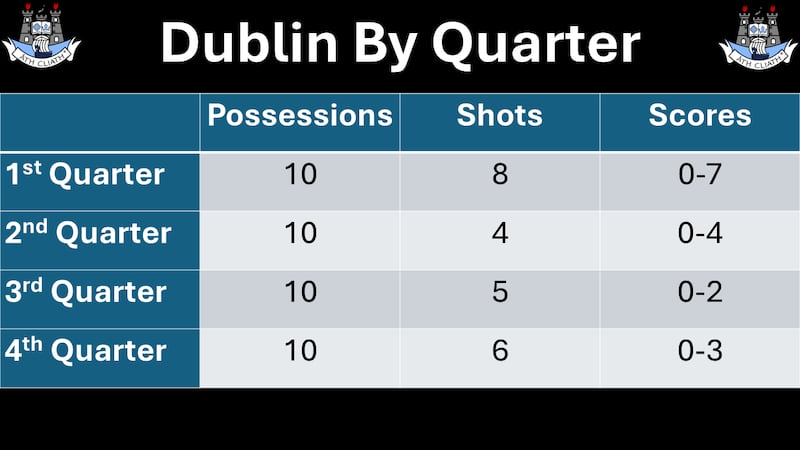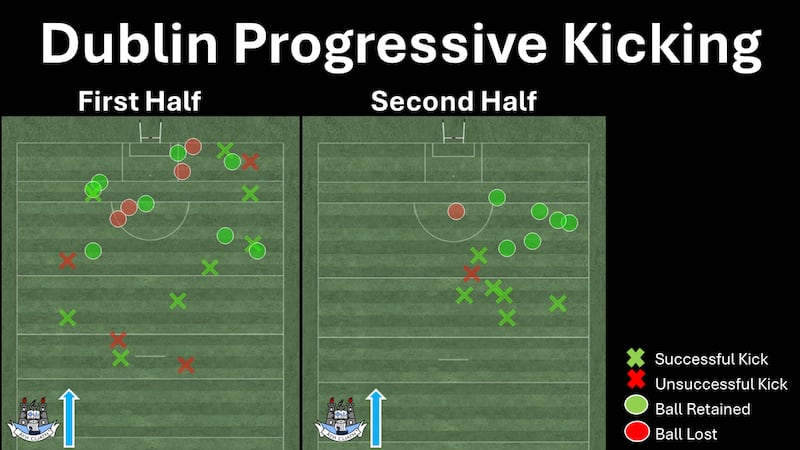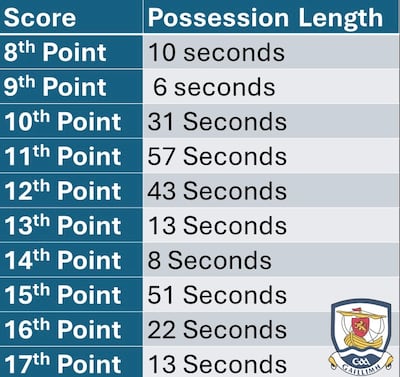A resourceful and energetic Galway managed to cause the shock of the Championship in the All-Ireland football quarter-final at Croke Park on Saturday.
Last week on the Second Captains podcast, Paul Flynn talked about how Dublin had a metric of getting 10 possessions, 8 shots and 6 scores per quarter during their peak. It was a good insight into the greatest team of all time and what they were chasing.
In terms of the weekend just gone where do Dublin fall in terms of those targets per quarter?
There was an unusual symmetry to having exactly 10 possessions in each quarter, with realistically only the first quarter matching the standards outlined by Flynn, of shots off 80% of possessions and shot efficiency of 75%.
READ MORE

The first quarter saw Dublin reach this target. This opening dominance was aided by a passive defensive set up from Galway, where they allowed Dublin make good use of the kick pass, leading to scores.
This kick passing was an aspect of the Dublin play which Galway really struggled with in the opening exchanges, as Dublin scored three points from these progressive kick passes. Con O’Callaghan was the primary target for these and remained the target throughout the first half before Galway curbed this threat.
In the second quarter, Dublin managed that target of 10 attacks again but only got four shots off, albeit with a 100% efficiency with 0-4 scored. The kick pass which had helped them so much in the first quarter was cut out somewhat, but Dublin still got two points from these attacking kick passes. Interestingly in the opening half Paul Mannion recycled kick passes back out the field for Sean Bugler’s two points – patterns.

Galway made excellent adjustments at half time to curb this kick-passing threat from Dublin, and they put significantly more pressure on the outside kicker, while also clogging the area in front of Con O’Callaghan to good effect.
As seen with the below pitch maps of Dublin’s kicking, they were way more conservative with their kicking in the second half as the restructured Galway set up proved difficult to navigate around. Dublin only managed to get one score in the second half from the use of progressive kick passing, a mark from John Small.

Dublin weren’t able to fully share the load in their attack as they were overly reliant on O’Callaghan and Ciaran Kilkenny, who both played to their usual high standards. Both were involved in a lot of what Dublin did well.
Kilkenny scored two points, won a free and assisted another three points. Con had even more impact on the game, he scored a point from play, converted two well taken marks, assisted a Brian Fenton score, won a converted 45 (bundling Conor Gleeson over the endline) and he also won the free for Dublin’s final score, which he converted himself.
The pick of Con’s scores was his 55th minute effort where he had to come out the field to gain possession before carrying hard at the centre of the Galway defence. He had to venture further out at this stage, as Galway’s tighter second-half defensive structure meant he went through a barren spell for service. A lot rested on the shoulders of Con in the final quarter to get scores and he was left with the final attempt at the posts, when there seemed no other Dublin player willing to accept the responsibility. A credit to the Galway defence.
The 69th minute turnover as Tom Lahiff fed James McCarthy on the outside was an indicator of how Galway pressed out that little bit more – as Lahiff received ball under the Cusack stand and was ushered back out the field and forced into the kick to McCarthy.
The origins of this turnover were arguably a result of the less aggressive kick passing from Dublin, as there was an easy mark opportunity as Brian Howard fed Ross McGarry, just before he passed to Lahiff, but the kick was cautious. The mark had served Dublin well all day and it was a scoring opportunity.
Damien Comer subsequently robbed McCarthy but Tomo Culhane’s defensive effort preceding this and his alertness was pivotal. While Comer didn’t register a score all day, his presence was huge in the second half, with two turnovers and a kick out won through raw physicality, and winning a dubious free when Mick Fitzsimons stripped him of the ball in the D in the 56th minute.
Galway converted from all of these, punishing Dublin. Going into the game, if you heard that both Comer and Rob Finnerty would be kept scoreless, you’d wonder where Galway were going to get their scores from. Galway’s scores came from everywhere and they came at pace in that second half – there was no dithering in possession as they looked to transfer the ball to the shooting zone and get the shots off.
An indication of the pace of their second-half attacks is shown that Dublin’s quickest second half possession resulting in a score was 23 seconds, while Galway scored six scores in less time than this.

Dublin specifically matched up their man markers Seán MacMahon, Mick Fitzsimons and John Small on the Galway trio of Damien Comer, Rob Finnerty and Shane Walsh. Dublin did snuff out these threats despite Shane Walsh still scoring some majestic points. However there was consequences as Dublin didn’t have any other recognised defenders to curb the additional Galway attacking threats.
John Small has been used in different roles for Dublin, but when he is forced to man mark it tends to leave others exposed and vulnerable to losing their individual battles. The losses of Davy Byrne and Lee Gannon were felt here, as Jack McCaffrey, Brian Howard and Sean Bugler would be more renowned for their on-ball contributions.
Dublin did have Eoin Murchan but physically he was a poor match up for many of the Galway players, which was really highlighted by the 24th minute kickout where Johnny Maher soared above him in a big mismatch – no score came from this, but it showed Galway were navigating their way around how Dublin were defending their kick out.
Galway brought a real physical edge to the game, none more so than Cillian McDaid who scored three booming points but it was the imposing nature of these points and his general demeanour where he etched himself on the game. So many Galway players did likewise, as players such as Seán Mulkerrin and Dylan McHugh won big moments that were vital to them coming out on top in that frantic endgame.
Paul O’Brien is a performance analyst with The Performance Process (twitter.com/NoPlanBGAA).















